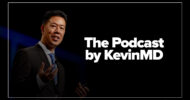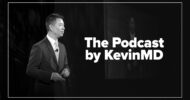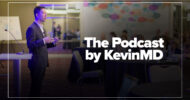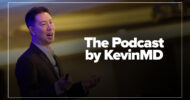Subscribe to The Podcast by KevinMD. Watch on YouTube. Catch up on old episodes!
Counselor and certified coach Mary Remón and oncologist Tiffany Troso-Sandoval discuss their article, “Clear communication is kind patient care.” They explore the common scenario of patients leaving the office more confused and anxious than when they arrived, overwhelmed by medical jargon and frightening online research. Mary and Tiffany address the root causes of poor patient communication, including physician burnout and compassion fatigue, arguing that “unclear is unkind.” They offer practical, powerful strategies (like using the teach-back method, addressing patient fears from “Dr. Google” directly, and validating emotions) to improve health literacy and build trust. This conversation explains how clear communication isn’t just a soft skill: it’s a critical tool for reducing patient anxiety and improving outcomes.
Our presenting sponsor is Microsoft Dragon Copilot.
Microsoft Dragon Copilot, your AI assistant for clinical workflow, is transforming how clinicians work. Now you can streamline and customize documentation, surface information right at the point of care, and automate tasks with just a click.
Part of Microsoft Cloud for Healthcare, Dragon Copilot offers an extensible AI workspace and a single, integrated platform to help unlock new levels of efficiency. Plus, it’s backed by a proven track record and decades of clinical expertise, and it’s built on a foundation of trust.
It’s time to ease your administrative burdens and stay focused on what matters most with Dragon Copilot, your AI assistant for clinical workflow.
VISIT SPONSOR → https://aka.ms/kevinmd
SUBSCRIBE TO THE PODCAST → https://www.kevinmd.com/podcast
RECOMMENDED BY KEVINMD → https://www.kevinmd.com/recommended
Transcript
Kevin Pho: Hi, and welcome to the show. Subscribe at KevinMD.com/podcast. Today we welcome back Mary Remón. She’s a counselor and certified coach. And we welcome oncologist Tiffany Troso-Sandoval. Their KevinMD article is “Clear communication is kind patient care.” Mary and Tiffany, welcome to the show.
Mary Remón: Thank you so much for having me.
Tiffany Troso-Sandoval: Thank you.
Kevin Pho: All right, so Tiffany, you are new to the show. Just briefly share your story and maybe you could jump into the article that you and Mary wrote.
Tiffany Troso-Sandoval: Sure, happy to. So the article came out about patients and how to discuss with them. Mary and I were discussing between the two of us about how oftentimes there are limiting factors to why patients are not getting the information from us that we need to explain to them.
Basically, I go through the scenarios that I’ve seen myself in the clinic. For example, a woman comes in who has metastatic breast cancer, and she’s been Googling all night looking up the different words in her PET scan report. Despite the fact that I had already reviewed that report with her, it didn’t stick. And so she went and tried to educate herself, then became much more overwhelmed, and then came back to me.
So the article is really looking into why that would happen. Why didn’t it stick? Why didn’t she hear me or understand? And why did she need to search for more information? Some of the things that we discuss is the fact that we often will speak in medical jargon, assuming that the patient actually understands us. We discussed the fact that when we don’t take the time to slow down and really explain what things mean and what it means to the patient, we’re actually wasting more of our own time. For example, if the patient doesn’t understand and then you have to have another three phone calls and another email message and then she has to come in again so you review things, if you had just slowed down the first time and spoken on her level, she perhaps would have avoided all of that.
We talk about compassion fatigue. We talk about things like how we have been so burnt out as physicians that chasing RVUs means we actually don’t have the time sometimes that we need to take. Sometimes we just don’t understand what the patient really needs. For example, I say, “You have stage two breast cancer and I think we’re going to need to give you adjuvant chemotherapy.” And the patient says to herself, “Am I going to die? What does this mean for me? Where am I going from this?” So we’re speaking on different levels completely. Hopefully, everybody will enjoy this article because it’s the reality I have found from being in the clinic. It was wonderful writing with Mary because she brought it in from the physician perspective. I’ll let her speak for herself.
Kevin Pho: So Mary, when you heard this story from Tiffany, tell us what your reaction was.
Mary Remón: I just think that Tiffany exemplifies the way I would love for physicians to speak with patients. I’ve seen her posts; she speaks directly to the patient in her posts. She’s an advocate and she’s so compassionate. I’m so glad that we connected because I even referred my friend to her and said, “Not only is she intelligent, she’s really compassionate.” They spoke yesterday and I think she just exemplifies the compassion that’s often missing in medicine and the communication skills that are so important.
So, when we partnered together on this, the thoughts that came up for me—one, you know, my background is in communication and psychology—is one of the quotes that you’ve probably heard: “People don’t care how much you know until they know how much you care.” A lot of times it may be tempting to go in with a lot of information and statistics and probabilities and diagnostic information when a patient is scared. Especially then, it’s so vital—and this is what Tiffany does so well—to connect with them first, to show that you care about the person, you care about their concerns, you care about the topic. Connecting first will allow them to hear everything else that you have to say. It’s helpful in public speaking. It’s helpful in all kinds of situations. It almost should be on a checklist for physicians: “Let’s check in with the patient’s emotional state and remember to show that you care and then give the information in a clear and compassionate way.”
Kevin Pho: Mary, the article mentions that sometimes physicians are emotionally numb and sometimes that can impede how they communicate with patients. So you are a coach; you talk to physicians about this very topic. What kind of advice do you give to these doctors who have to battle compassion fatigue and being emotionally numb that impedes their communication with patients?
Mary Remón: It’s really, really complicated and complex. But I just got off the phone with a physician right before this podcast, and we talked about being emotionally numb. A lot of times, burnout and compassion fatigue isn’t just the long hours. It’s a disconnect from the purpose. I think physicians want to connect with their patients. They went into it because they care, and yet compassion fatigue comes from prolonged caring with too little self-care. I think also, it’s probably impossible—you can tell me, Tiffany—but to be able to care all the time with such intense life and death things has to take its toll.
And so, there are things that we work on in terms of exercises, reflective questions to reconnect with your purpose, and micro-breaks throughout the day. It’s complicated, but I think sometimes physicians need to take some time. You can tell me what’s worked for you, Tiffany, because I think you exemplify this and I don’t know how you did it so well.
Tiffany Troso-Sandoval: I can say that I was 25 years in practice and that I didn’t always do it well and that it’s still a work in progress. I have now found that it’s so much easier to do all of these things, to be emotionally available for your patients as well, when you have more time for self-care. I completely agree with that.
So as you know, I had to retire due to my own medical illness, and so in some ways, I’m seeing that as a bright light there. It was my chance at remaking this and working on becoming the best physician I can be and helping patients from another standpoint. When I was in the clinic and I was running from room to room, I used to say that each door that I opened was a different world. You have to meet the patient where they are. You have to understand their emotional state and communicate with them. And it is exhausting.
And so some things that I would do… we would laugh in the back room, sometimes over silly things. And sometimes that emotional release about joking about something silly helps. Walking outside at lunchtime if it was sunny out could just clear your brain like nothing else if you ask me. And then little things like, “What are we having for lunch?” We literally used to start talking about it at like 10 o’clock in the morning: “Where are we going to order from today?” And it was the highlight of the day; we would all order together. It was a sense of community where we would all order from one place together. Those are little things from the clinic, but somehow those little things helped keep you grounded in real life.
Kevin Pho: Tiffany, in the article, you mentioned that you used to shut down difficult questions. What was the turning point that made you realize that you needed to lean into discomfort instead?
Tiffany Troso-Sandoval: Yeah. So again, there was no sharp turning point. It was a realization over time that the less you answered, the more questions they had. It really made it very difficult for myself as well as for the patient. And I also noted that if I didn’t give them the answers they were looking for, they would look somewhere else and then they would come back to me potentially with misinformation.
And so it was always better to give them the real answers the way that I saw them, the perspective of where they’re coming from. Mary and I have discussed the term “clear.” Clear is kind. Being clear to a patient is actually being kind in terms of helping them to get through their diagnosis, their treatment recommendations, and really helping to digest all the information that you’re giving them.
Kevin Pho: And you guys quote Brené Brown in your article, right? Where she writes that “Clear is kind, unclear is unkind.” Mary, why do you think so much medical communication defaults to being unkind by being vague?
Mary Remón: It’s a good question. Some of it is not intentional; it’s just medical jargon, and people might not realize when they’re using jargon. Sometimes some physicians may want to protect the patient’s emotional state or not overcomplicate things, or they’re in a hurry and they don’t have time. So I think it’s multifactorial. Some people don’t tell their patients their prognosis even. Some patients might not want it. Personally, I would want to know all the information there is. Tiffany, do you think it’s a combination of those things?
Tiffany Troso-Sandoval: Oh, absolutely. And one thing that I have learned over the years also that’s very important is to ask the patient how they want to receive their information. Do you want a lot of detail? Do you want to know about their prognosis? Do you want me to explain the science behind the treatment that I’m recommending? Because, like I said, every room you walk into is a different world.
It always used to upset me when I was talking to a patient and the family member was in the room and say, “Well, is she going to die? How many months does she have?” I’d look at the patient immediately and try and gauge if they wanted me to answer that or not. But on the other hand, I do think that it’s very important to give the patient the information that they need. And sometimes I have found that by avoiding the question, I am not giving them what they need.
And so, for example, if I find that if the patient is asking me something very specific, say about their prognosis, and I kind of brush it off like, “Well, it’s too early to really discuss that. Let’s think about it later,” that really doesn’t help them very much. But I could say in oncology though, one thing for sure is that statistics are one thing and our medicine is changing so quickly. So oftentimes I’m avoiding the question because maybe I don’t really have the answer because there are so many nuances to our treatments and their survivals at this point. So whether or not the patient responds to immunotherapy gives them a completely different prognosis than if they blow through their chemotherapy. And so sometimes the wait-and-see is actually the truth. But I do think that sometimes we avoid those hard conversations because we don’t want to let the patient down. I don’t want to hurt them. I don’t want to disappoint them or make them upset, so to speak.
Kevin Pho: So, yeah, I completely agree with that. I think that sometimes asking that patient, “What do you prefer? How do you prefer to receive that information?”—kind of individualizing how you share that information—is tremendously important. I don’t think enough doctors do that enough, just asking patients: “What do you prefer?” Because even in my own primary care clinic, there’s a spectrum of how patients want to receive that information, right?
Mary Remón: I just think in listening to what Tiffany was saying, it’s best not to assume what someone wants. And sometimes maybe we are assuming that they don’t want to hear something uncomfortable. Maybe it’s because we’re uncomfortable.
Kevin Pho: Tiffany, when it comes to communication, other than not using medical jargon and speaking in terms the patient can understand, what are some specific techniques that physicians can use in the exam room to ensure that they’re not speaking in medicalese and speaking at a level that patients can understand? What are some specific ways we can do that?
Tiffany Troso-Sandoval: Well, I can tell you from my own experience, one of the things that I’ve always done is I take notes on what I’m telling the patient. I make drawings and I write down the important words. As I joke to them, I’m taking the notes for them because I know how to spell everything. And then they get a copy of those notes. That gives two things, right? It gives them something tangible that they can go home and remember with, but it also slows me down because I can speak much faster than I can write in cursive, for example. And so when I’m writing the notes, it slows me down and it allows me to check in with the patient: “Did you understand that? Do you understand what this means here?” I think that is another technique that’s really important: checking in with the patient to make sure that they’re following you. You can also have them teach back to you.
I think that’s particularly important in critical situations like cancer discussions. I often will ask them, “What did you hear? What does that mean to you?” so that I understand where they perceived what I said. Some other things that you can do if you’re not taking notes is to make sure that there’s somebody else taking notes with you so that they have the notes to take away from them. Those are the main things that I would do: checking in, taking the notes to slow myself down, and also pausing and allowing them to ask questions. I talk about that a little bit in the article. Sometimes if you think you’re done, you jump up in your mind and say, “OK, see you next week, Mrs. Jones.” That’s a really good time to pause because that’s usually when some of their most critical questions that they’ve been holding onto will come out. So, not making sure that you’re really done before you leave the room.
Kevin Pho: And Tiffany, just to follow up on that, you also mentioned the pressure of RVUs and 15- to 20-minute appointments. So how can physicians balance being clear in a communication standpoint versus not falling behind and the efficiency pressures that they face?
Tiffany Troso-Sandoval: Geez, I wish I had the answer to that. That’s the million-dollar question, isn’t it? I think that all physicians at this point, especially in busy clinics, should have a scribe. At one point I had a virtual scribe that I was using, and I was afforded that because I had my medical issue with my eyes. It’s life-changing. If somebody is taking notes on what you’re saying and then can put it into the chart so that you can be actually present with your patient… I think that the switch to these electronic medical records from the days when we used to just scribble a few things down on a piece of paper has really changed how we practice medicine and how we see patients. So I would say, if at all possible, if it’s available to you, I think a scribe is extremely important.
Short of that, I would try to take notes on what I was saying for myself. I would have a scrap note where I was just writing down key points that I was discussing with the patient instead of trying to transcribe it myself in the EMR while I was there with the patient. Because I know it’s a necessary evil to make these EMRs at this point, but if you’re typing in a chart, you’re not emotionally present for that patient and you’re not really connecting with them. And so we are all caught in a very difficult situation right now. Anybody that has any better suggestions on how to get rid of the EMR mess, we’d all love to hear it.
Kevin Pho: We’re talking to Mary Remón and Tiffany Troso-Sandoval. Mary is a counselor and certified coach. Tiffany is an oncologist. And their KevinMD article is “Clear communication is kind patient care.” Now I’m going to ask each of you just to end with some take-home messages that you want to share with the KevinMD audience. Mary, why don’t you go first?
Mary Remón: One thing that comes to mind—and I learned this from a physician that I work with—is I love Tiffany’s open-ended questions and to assume that the patient has a question by saying, “What questions do you have?” versus “Do you have any questions?” I’ve tried that with some of my own clients and I found that once I started saying, “What questions do you have?” probably about 30 percent of the people had questions.
I used to also say, “Does that make sense?” I stopped saying that because the onus for making sense is on the speaker, not the listener. So now I say, “I’m not sure if I said that clearly. Would you like me to try again or would you like me to explain that better?” Clear is kind.
Kevin Pho: And Tiffany, we’ll end with you. Your take-home messages.
Tiffany Troso-Sandoval: So, I think my message to other physicians is to learn to put yourself first. Put you first, because at the end of the day, if you’re not taking care of yourself, your own mental and physical well-being, you can’t do it well for other people as well. It’s like in the jet plane: when the oxygen drops, you put yours on first before you put on somebody else’s. And so I just implore everyone to make sure that you’re making time for yourself because you will show up better for your own patients.
Kevin Pho: Mary and Tiffany, thank you so much for sharing your perspective and insight and thanks again for coming on the show.
Mary Remón: Thank you.
Tiffany Troso-Sandoval: Thank you for having us. Thanks.


























